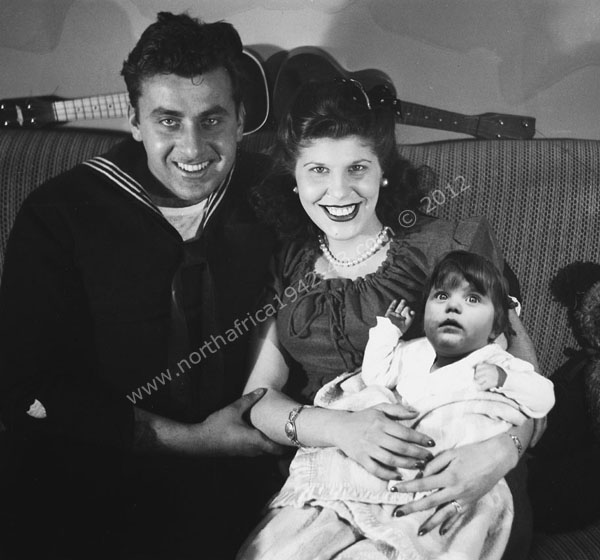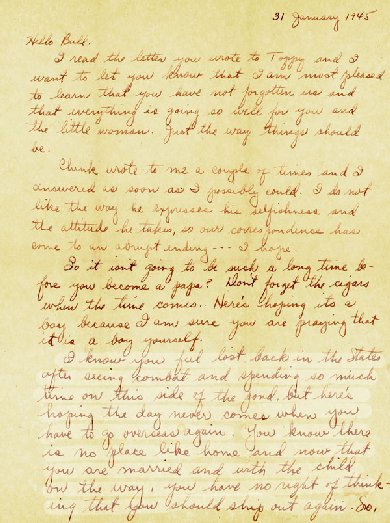








U.S. Coast Guard Veterans(Brief History - Operation Torch)On
9 November 1942, Commander Roger C. Heimer (USCG) anxiously peered into
the distance as word was passed that enemy aircraft were approaching.
His vessel, the transport Samuel Chase (APA-26), for the past day had
repelled successfully several enemy air attacks. Moments seemed like
hours as everyone on the bridge strained to identify the planes.
Finally they could be seen clearly, they were German dive bombers. As
the dive bombers screamed out of the sky Heimer prepared Chase to get
underway. His ship's gunners maintained a scathing fire on the aircraft
as they released their bombs. Bombs missed the Chase on two separate
occasions by just yards but they damaged the nearby transport Dempo. At
dusk a torpedo plane approached the large Coast Guard transport. The
plane came under immediate fire but banked behind an anchored British
transport. With Chase now underway, Heimer began maneuvering the nearly
five hundred foot vessel in a narrow bay to avoid the aircraft. Coming
from behind the transport the torpedo plane flew toward the Chase just
over the water and released its torpedoes. Heimer managed to steer the
transport so that both torpedoes missed the stern by 100 yards. These
tactical maneuvers won the ship's crew high praise and Heimer a bronze
star. This
was just one minor incident of the Coast Guard's involvement in the
invasion of North Africa in November 1942. The invasion was the first
offensive operation that the United States undertook against Germany
during World War II and was the largest amphibious operation ever
undertaken. Dubbed Operation "Torch," this strategically important
expedition allowed the Coast Guard with its unique experiences to play
a significant role. Condensed Source Material: Robert M. Browning, Jr. Meeting Marvin J. Perrett
in May 2006 provided an opportunity in getting as close as
one could in understanding the chaotic scene of a beach
invasion
cluttered with mayhem, horror, and small boats.
The Coast Guard specialized in the handling of small boats designed to
carry troops and equipment. Marvin died May 7th 2007,
(less than a year after we met). His love for piloting
small boats was evident as you'd occasionally see him at the helm of a
restored LCVP, near his home in Lake Pontchartrain. Marvin's training
in the Coast Guard was no different than that of the Navy. As Marvin explained; the only difference was the presence of the Shield on the right sleeve. In numerous conversations with Marvin
he also touched upon the age old rivalry between the United States
Coast Guard and the United States Navy. This brings us right back to
this particular story and an understanding of the environment aboard
the Thomas Stone. In the summer of 1942, a small group of Coast
Guardsmen boarded the ship, (trained specifically in the handling
of small boats). Coast Guard veteran Robert Fraley summed it up nicely;
"Here we were; 'hot shots', considered as intruders on their
ship." As Coast Guard historian Mike Walling
would state: "These sailors, sometimes called 'Hooligans,'
were generally not welcomed on a Navy transport. But when the
pressure was on to get the job done, they knew exactly what
had to be done; both Navy and Coast Guard coxswains, motor macs,
and bow hooks would work effectively side by side." 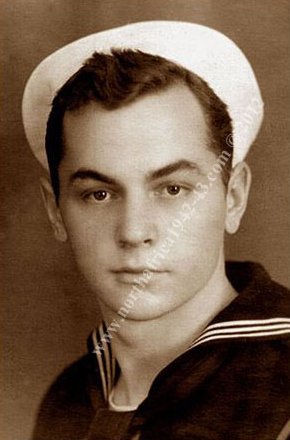 Robert B. Fraley Interviews: (June 2009 & January 2011). The highlight of the journey, (tracking down 25 Coast Guard veterans), in the story, was Robert B. Fraley and hid wife Betty. One memorable telephone conversation in the summer of 2009 opened a door of emotions as I introduced myself. With surprise and disbelief that I actually found them, Mrs. Fraley told me about her husband's deep feelings during those dark days on the Thomas Stone in North Africa. When Robert Fraley and I spoke, it became apparent that the passage of time years did not cloud his memory: "Bennehoff was not especially fond of the Coast Guard. It seemed we were given the dirty jobs aboard the ship and all of us wished we were on the USS Chase instead. We survived a torpedo, bombing, strafing, and a storm which nearly capsized the ship. I will say, had it not been for Bennehoff's stiff discipline, we may not have fared as well, in fact the training saved our asses." Bob Fraley enlisted in the U.S. Coast Guard 12/18/41, exactly eight days after my father. He went to trade school until 5/28/42, and was assigned to the USS Thomas Stone until 7/1/43 when he and most of the other Coast Guardsmen were transferred to the Naval Supply Depot in Oran, Algeria. He was then transferred to the U.S. CC District Office, NY 9/22/43 to 7/21/44 when he was discharged. In 2009 my sister Toni located yet another piece of memorabilia. The address entry, below left, (part of our father's memorabelia), shows Robert Fraley's name and address. This and the Coast Guard muster from NARA began the search for Coast Guard veterans aboard the USS Thomas Stone, (some 64 years later). There were 25 in all. Robert Fraley was the last surviving Coast Guard veteran in the group. He died December 9, 2012 - I will miss him dearly. 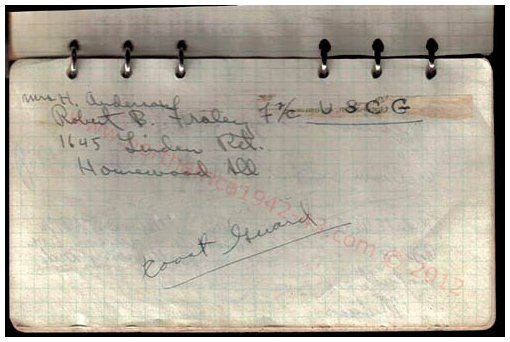 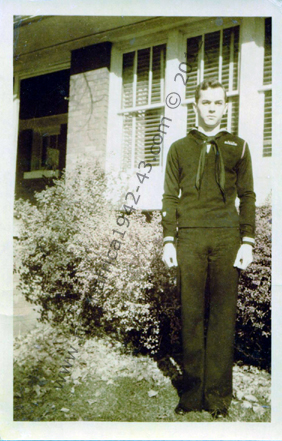 During one of many terrifying air raids, JU88's strafed the deck of the Thomas Stone. As Bob and a shipmate carried a wounded sailor below deck, Bob didn't realize he was also wounded from a piece of shrapnel. With his head bleeding, a medic treated his wound, and Bob received a purple heart. 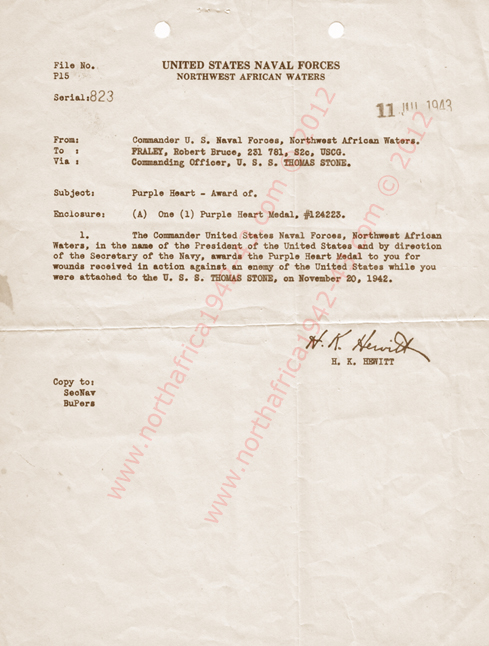 Anthony L. Fraticelli Two
weeks before war broke out, Anthony tried to enlist in the Coast
Guard but was turned down for having a few extra pounds. Dec 7th 1941,
changed that, and he successfully enlisted on Dec 10th 1941. Anthony
grew up on the streets of Hell's Kitchen, also known as Clinton and
Midtown West. His love for the water, and expert ability for
woodwork, seemed a good fit for a sailor. He hoped the Coast Guard
might put him closer to home, but that would change when he was
assigned to the Thomas Stone. He became an expert swimmer, and
also received training on 20mm anti-aircraft guns during the summer of
1942, (months before shipping out). When the Stone was struck
early morning November 7th, 1942, Anthony was on the flying bridge
manning a 20mm. In his memoirs, he wrote about the dangerous LCV
journey which almost led to disaster. His gun training would
prove invaluable as he and his shipmates tried desperately to hold
off attacking Stukas and JU88's targeting the helpless ship
which had been washed on the beach from a fierce storm. I dedicate this documentary film to my father. He
passed away March 19th 1991.
Growing up in New York City Anthony can be seen in the center with his buddies on either side. The 9th avenue L train can be seen in the background. 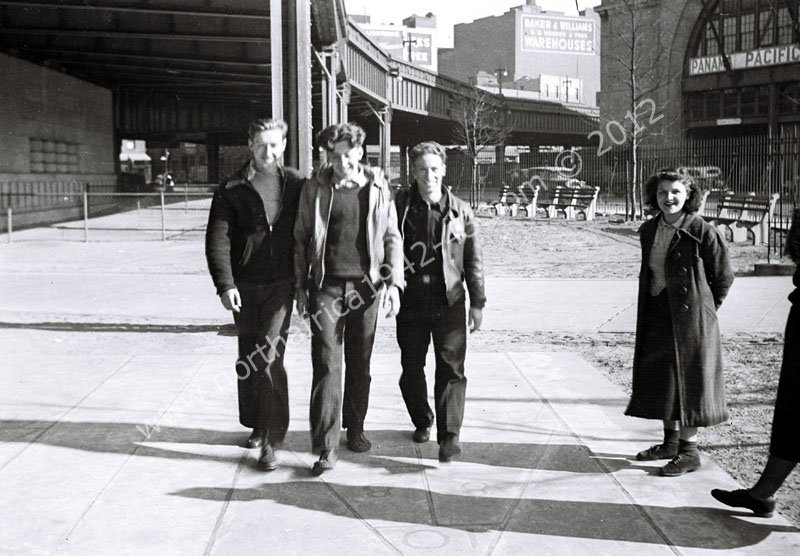 Growing up during the depression years, as with other young men of the same age, Anthony took advantage of a new opportunity to earn a living, and joined the Civilian Conversation Corps. Leaving his family far behind he got on a train bound for California and worked on the construction of of Shasta Dam. The work was difficult, the hours were long, but the experience would prove valuable for many young men who would later prepare for war. While in California Anthony unfortunately lost a good friend, (Tommy O'Donnell) who was accidentally killed by a falling tree. Newspaper clip courtesy Trinity Co. Historical Society, Wearverville, Ca. - Thank you - Joan Working on clearing the site for the construction of Shasta Dam in Northern Sacramento Ca. 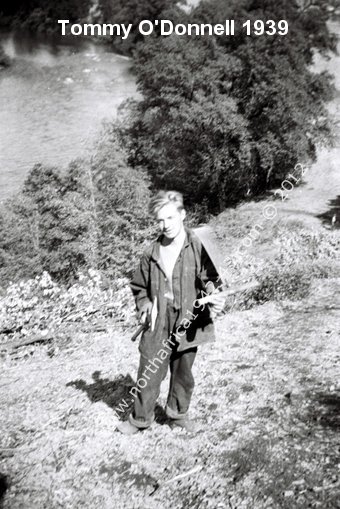 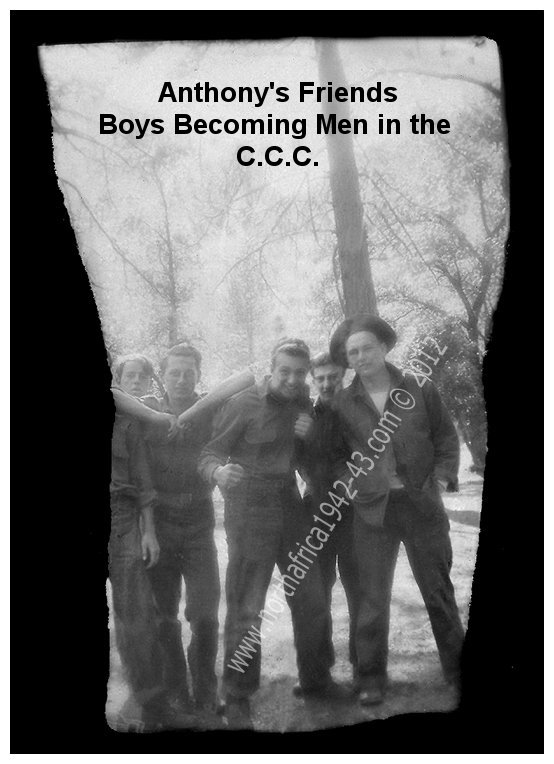 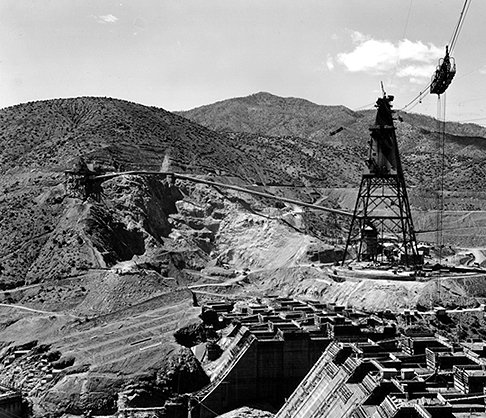 The Construction of Shasta Dam
C.C.C. Barracks
- Construction Site - Shasta Dam
Coast Guard Barracks - Anthony L. Fraticelli
Birth of their
first child, Antoinette Fraticelli,
Letter revealing desire to return to combat
May 1st 1945, six days before Germany surrendered. Maurice C. Poulin Interview July 8th 2013 in Nahant Massachusetts. One of the most memorable interviews was an entire family event at Maurice's home with the a scenic view of the Boston skyline just across the bay. Of notable interest was that Maurice, (90 years old at the time), served on the Leonard Wood with my father, Anthony Fraticelli in North Africa 1942-43. Born the same year, they didn't know each other, (my Dad was aboard for only 2 months). Both he and my Dad attended the USS Leonard Wood reunion in 1988 held at Pokagon State Park Angola Indiana. The next reunion in April of 1999 would also host the USCG Amphibious Fleet Monument Dedication held in New London Connecticut at the USCG Academy. Unlike my Dad who returned to the U.S. serving the remainder of his time, Maurice continued to see horrific combat at places like Kwajalein Atoll, Eniwetok Atoll and Perry Atoll in the Marshall Islands, South Pacific. Maurice was a career Coast Guardsman who finished his service in Boston and eventually in Nahant where he relocated his family and retired in 1966. While serving on the Wood, he affectionately acquired the name 'Frenchy' because of his unique mastering of the French language which naturally was advantageous while stationed in French North Africa 1942-43. 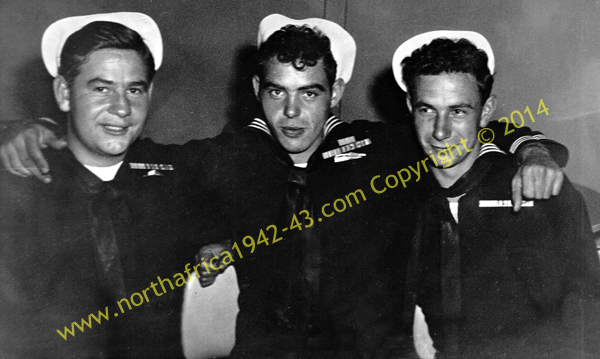 Paul Gilliken - Maurice Poulin - Royce Squires 2nd Division aboard the U.S.S. Lenoard Wood Photographs below from the visit and interview with Maurice Poulin and family. Extra special thanks to Maurice's son, Ed! Maurice is an excellent ship modeler! How does he get those ships in those bottles? Photos and memorabilia provided by the veterans and their families. This independent documentary is not intended to be a comprehensive account of the war in North Africa 1942-43. The completed film will feature rare interviews from veterans connected to the story. The search to locate veterans within this time frame was very difficult. With no funding and a small film crew who sporadically assisted with re-creations, the bulk of production falls upon one individual. Contributions of any kind are welcomed. northafricaww2survivors@gmail.com Photos, illustrations, art work or interviews may not be reproduced, copied, stored, manipulated or redistributed without the expressed permission of the author. Michael Fraticelli - North Africa 1942-43 Survivors' Stories © 2015 |

